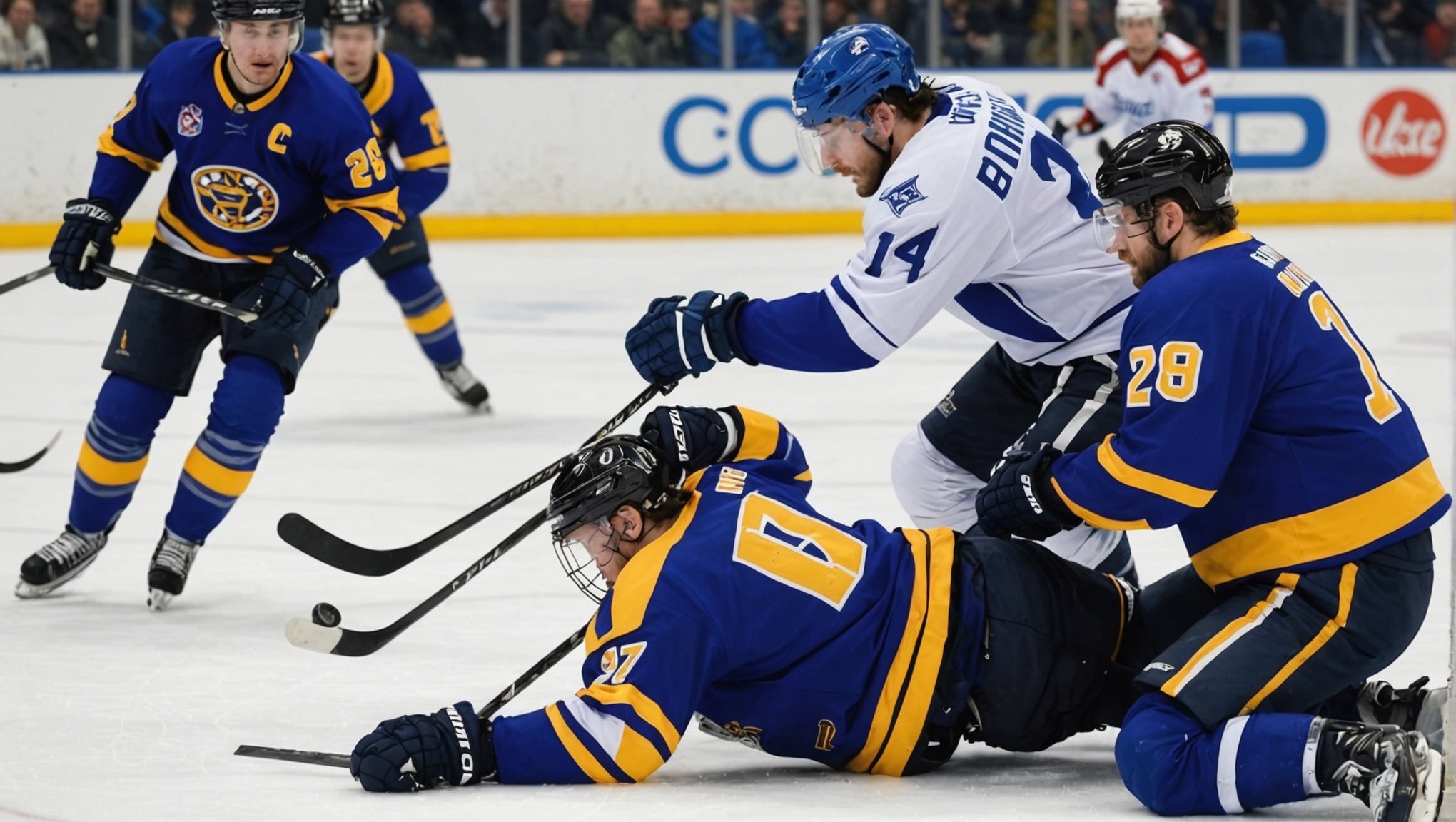Overview of Injuries in UK Ice Hockey
Ice hockey, known for its thrilling speed and agility, also carries risks, reflected in the injuries in ice hockey statistics. The player safety statistics in UK ice hockey leagues reveal a notable injury rate among players. Various types of injuries, such as concussions, sprains, and fractures, are prevalent within the sport.
Statistical Analysis of Injury Rates
The injury rates in UK ice hockey show that over 50% of players have reported an injury during their career. This statistic highlights the physical nature of the sport, necessitating stringent safety measures. Studies indicate that concussions account for a significant portion of these injuries, impacting players’ health and game participation.
Have you seen this : Unlocking the Slopes: Innovative Techniques UK Ski Instructors Can Use to Teach Advanced Skills to Novice Skiers
Common Types of Injuries
Players frequently experience concussions due to head impacts during games. Sprains, particularly of the lower body, and fractures occur commonly from falls or collisions. The player safety statistics emphasize the need for improved safety protocols to reduce these incidents.
Impact on Player Participation and League Dynamics
Injuries can sideline players for extended periods, altering team dynamics and league standings. Consequently, teams often face challenges in maintaining competitive performances, while players confront setbacks in their athletic development. Enhanced safety measures and training are crucial to reducing injury prevalence and ensuring the well-being of players.
Also read : Top Exercises to Boost Javelin Throwing Distance for UK Athletes
Essential Safety Measures
Ensuring the safety of athletes and participants is paramount. Implementing standardized safety protocols across leagues can significantly mitigate risks. These protocols encompass a wide range of injury prevention strategies, starting with routine equipment inspections. Ensuring that all gear and facilities are in optimal condition can avert potential hazards. Any flaws in equipment, such as padding, helmets, or even the playing surface, must be repaired immediately to prevent accidents.
Training on emergency procedures plays a crucial role in safeguarding participants. Coaches and officials should undergo comprehensive training to address emergencies swiftly. This could involve understanding how to perform first aid, using Automated External Defibrillators (AEDs), or executing efficient evacuation procedures.
Additionally, a culture of safety can be fostered by adhering to protocols. Some examples include:
- Regular safety drills and workshops for staff and athletes.
- Clear communication channels for reporting concerns.
- Continuous updates to safety protocols reflecting technological advancements or new regulations.
Combining these measures ensures a proactive approach to safeguarding well-being, emphasizing that prevention is as imperative as response. Embracing these strategies not only protects but also reassures athletes, coaches, and officials, allowing them to focus on performance, confident in their safety framework.
Best Practices for Equipment
To ensure maximum safety while engaging in sports or activities, familiarising oneself with equipment standards is crucial. These standards dictate what qualifies as protective and effective protective gear.
Importance of Proper Fit
A properly fitted helmet, for instance, can dramatically reduce the risk of injury. Helmets should sit low on the forehead and shouldn’t move when fastened. Similarly, mouthguards must mold precisely to the teeth, ensuring optimal protection while allowing for easy breathing and speaking. Pads and guards should also conform to body shape to distribute impacts evenly.
Latest Advances in Protective Equipment
Recent innovations in protective gear focus on lightweight materials and ergonomic designs. Helmets now incorporate multi-directional impact protection systems (MIPS) to better manage angled impacts. Similarly, smart wearables with embedded sensors offer real-time feedback on performance and safety, aiding in both training and injury prevention.
Guidelines for Equipment Use
Using gear correctly is as important as wearing it. All protective gear like helmets, pads, and mouthguards should be donned every time, regardless of skill level. Regular inspection for wear and tear is vital, alongside adherence to the manufacturer’s equipment use guidelines. Following these practices ensures safety and prolongs the gear’s lifespan.
Training Protocols for Players
In the realm of player training, injury prevention plays a pivotal role. Developing comprehensive injury prevention programs is imperative to maintain a player’s peak performance while minimizing the risk of injury. Such programs often emphasize proper skill development techniques, particularly aiming to strengthen muscles and improve flexibility.
Strengthening and conditioning exercises are cornerstones of effective player training protocols. These exercises are designed to enhance a player’s endurance, agility, and power, crucial elements in any sport. By integrating these exercises into daily routines, players can significantly boost their performance on the field.
When it comes to sports that involve physical contact, mastering safe body checking and contact play techniques is essential. Coaches focus on teaching players the correct form and timing to execute these moves, thereby reducing the potential for injuries. Players who are well-versed in safe contact methods are not only better protected from harm but can also make more strategic plays during games.
Overall, a holistic approach to player training that combines injury prevention, conditioning, and safe contact techniques ensures athletes remain competitive while prioritizing their health and well-being.
Coaching Strategies to Enhance Safety
Creating a safety-conscious environment is pivotal in sports. Establishing a culture of safety within teams ensures players are always aware of best practices and risk mitigation. This proactive approach involves embedding safety into the team’s ethos, encouraging players to prioritise their well-being.
A key strategy for communicating safety protocols to players includes clear and consistent messaging. Coaches should utilise varied communication channels, both digital and face-to-face, to reach every team member effectively. Regular meetings dedicated to safety can also reinforce the importance of adhering to protocols.
Ongoing education is crucial for coaches. Workshops and training sessions on injury prevention provide the knowledge they need to foster a safer sporting environment. This training should cover the latest advancements and techniques in player protection, ensuring coaches are equipped with up-to-date information.
Player development programmes should incorporate safety into their core, integrating sessions on safe practice techniques and the importance of maintaining equipment. Coaches can enhance understanding by including real-life scenarios and case studies, which offer practical insights into preventing injuries.
Coaching best practices not only enhance performance but also safeguard players’ health. By investing in safety education and communication, teams can thrive both on and off the field.
League Regulations and Policies
In the world of ice hockey, League Guidelines play a crucial role in maintaining competitive balance and ensuring the safety of all participants. Let’s dive deeper into the current and proposed measures.
Review of Current Regulations
The present League Guidelines in UK ice hockey emphasize a wide range of Regulatory Safety Measures. Current regulations focus on player conduct, equipment standards, and coaching protocols to minimize injury risks. These measures ensure that all participants experience a game that is both competitive and safe. However, enforcement consistency and adaptability to emerging challenges remain pivotal.
Proposed Changes for Improved Safety
To further enhance player protection, several proposed changes to existing safety policies are being considered. Introducing advanced helmet technology and stricter penalties for high-risk plays are some of the key initiatives. By integrating these updates, the league aims to significantly reduce injuries. These proactive changes, supported by evidence-based research, highlight the league’s commitment to Regulatory Safety Measures.
Enforcement Mechanisms
To ensure compliance with regulations, robust enforcement mechanisms are necessary. Regular inspections and a transparent reporting system will be vital components. This approach fosters an environment where teams and players are more likely to adhere to the guidelines, thereby promoting a safer playing field for everyone.
Case Studies and Real-Life Examples
Exploring case studies provides valuable insight into how leagues have successfully implemented safety initiatives to protect their players. A standout example is the NFL’s Head Health Initiative, which significantly reduced concussion rates over the past few years. This initiative involves multiple facets, from enhanced helmet safety standards to more rigorous protocols for identifying and managing concussions.
Injury prevention success stories spotlight the commendable efforts in the English Premier League (EPL). By incorporating advanced data analytics and introducing mandatory rest periods, several clubs reported lower injury rates among their players. This approach underscores the vital role of technology and strategic player management in protecting athletes.
Bringing attention to these real-life examples allows us to glean lessons from organizations prioritizing player safety. The Australian Football League (AFL), for instance, demonstrated remarkable outcomes through education programs focused on tackle techniques and player awareness. By nurturing a culture of safety, the AFL effectively mitigated serious injuries while maintaining the sport’s dynamic nature.
In summation, such case studies underscore the importance of a comprehensive, multi-layered approach to sports safety, combining technological advancements, player education, and evidence-based strategies to achieve injury prevention success stories.
Expert Interviews and Insights
Delving into the world of ice hockey safety, our conversations with expert professionals shed light on crucial best practices. A seasoned coach highlighted the importance of regular safety audits, emphasizing how they prevent injuries by identifying potential risks early on.
Trainers, especially those with years of experience, stress the significance of tailored training programs. These programs not only enhance players’ skills but also incorporate preventative measures to minimise risk. Meanwhile, medical professionals advocate for comprehensive health checks. They point out that understanding players’ unique physical needs can drastically improve safety protocols on and off the ice.
Looking ahead, experts envision a future where safety measures are dynamically integrated into all levels of the sport. With advancements in technology, smart equipment is anticipated to play a significant role. This innovative gear is set to monitor real-time data and provide immediate feedback, thus elevating the overall safety standards.
These professional insights provide a roadmap for the ice hockey community to adopt more efficient safety strategies. As the sport evolves, there lies an opportunity to prioritise player welfare, ensuring the UK ice hockey scene thrives while keeping safety at its core.
Recommendations for Emergency Procedures
When it comes to managing emergencies, establishing robust emergency protocols is crucial. These systems ensure that during critical situations, every step is documented and easily executed.
Developing a Comprehensive Emergency Response Plan
To begin, a comprehensive emergency response plan must be developed. This plan should include a detailed sequence of actions and clearly defined roles for all team members. It’s important to regularly update these plans to integrate new risks or learnings from past incidents. These protocols serve as a blueprint for action when seconds count.
Training for Medical Personnel
Training for medical personnel plays a vital role in effective emergency protocols. Medical staff members should partake in regular training sessions, which may include simulated emergencies to practice rapid decision-making. These training sessions ensure that medical personnel remain proficient in performing their duties effectively during actual emergencies.
Communication Protocols During Emergencies
The success of emergency protocols often hinges on effective communication strategies. Establishing a reliable method of communication ensures that all relevant parties are informed swiftly. This involves designating key personnel to convey information accurately and promptly, thus facilitating swift response actions. Communication protocols keep everyone on the same page, significantly reducing confusion during high-pressure situations.











